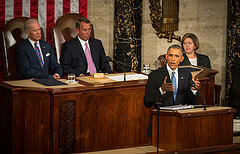
Two weeks ago, President Obama stood before Congress and addressed the nation with his State of the Union Address. Some dislike this long-standing precedent and argue that it is outdated. However, it is a requirement of the Constitution and the same type of ceremony takes place at almost every level of government throughout America.
There’s a reason for leaders to lay out new agendas. Citizens have a right to know what is planned and democracy works best when people express approval or disapproval. Taxpayers will ultimately pick up the tab for spending and citizens will see their everyday lives impacted by the success or failure of their leaders’ efforts.
With much less pomp and ceremony, cities, states and many universities also have long-standing precedents to have leaders address constituents and lay out their plans and goals. The speeches provide an interesting insight into trends and issues that governmental jurisdictions throughout the United States will be focusing on in the coming months.
In his recent State of the State address, New York’s Gov. Andrew Cuomo laid out 66 proposals covering everything from economic development to public safety. He discussed his plan to cut taxes on small businesses and boost their profitability. He noted that small businesses provide 43 percent of the jobs and the state’s economy is dependent upon them. Additionally, Cuomo wants to modernize the airports and build a $450 million Air Train to make travel to LaGuardia more efficient.
The LaGuardia AirTrain will likely cost about $450 million, but it will streamline travel for 27 million people. Cuomo’s commitment to small business was demonstrated again when he announced his desire to double New York’s State Venture Capital Fund to $100 million.
The state of Arizona will try to simplify the tax code to make taxes more predictable and reasonable for both businesses and citizens. Additionally, like in almost every other state in the country, Gov. Doug Ducey plans to make education a top priority.
Washington’s governor said the state will focus on new technologies – especially those related to economic development. Green technology was singled out for the important role it plays in economic development. Reminding citizens that the state is known as the Evergreen State, the governor focused on the challenge of carbon pollution throughout the United States and implied that the state is a major player. Washington is home to many solar manufacturing and renewable energy companies. Some of the newer solar technologies are revolutionizing the way renewable energy is stored. With these technologies in mind, Gov. Jay Inslee hopes to create a carbon action plan to boost and invigorate green enterprises within the state.
Greg Abbott, new governor of Texas, has listed education, transportation and water as high priorities. He also said that he will look carefully at tax reduction and will veto any budget bill that does not offer lower taxes.
California’s Gov. Jerry Brown announced a bold plan to promote a climate change agenda. He hopes to increase the state’s renewable energy generation to 50 percent in three years and will lead efforts to double the efficiency of existing public buildings. Brown also advocates investments in infrastructure and will lead efforts to reduce the state’s reliance on petroleum products.
Gov. Scott Walker of Wisconsin spent much of his State of the State presentation time discussing his desire to downsize government. He will also work to reduce taxes and make government more responsible to taxpayers. Walker has been mentioned as a presidential candidate in 2016 and many of his priorities for Wisconsin resonate with his party’s national agenda.
There are many new leaders in 2015 and they have laid out aggressive and visionary goals. It will be interesting to watch what happens in the coming months as history is written in America.

